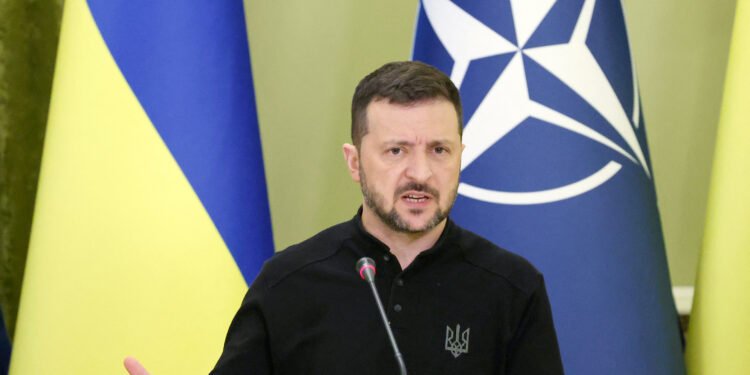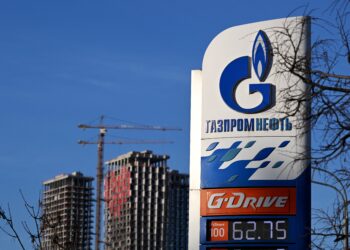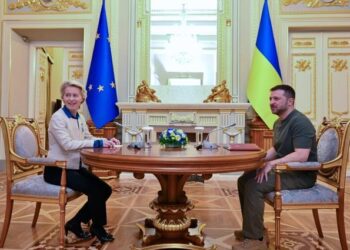Brussels – Ukrainian President Volodymyr Zelensky is expected to attend the European Council starting tomorrow (Oct. 17) in Brussels, during which he will present to the leaders of the Twenty-Seven his “plan for victory,” which he had already anticipated in recent weeks and whose main elements he unveiled today to the Kyiv Parliament. It is a list of strategic priorities that should enable the aggrieved country to sit at the negotiating table from a position that is not one of clear inferiority—or at least these are the intentions. But the road appears anything but downhill.
The plan has five main points: Ukraine’s entry into NATO, increase in its defence capabilities, deterrence to new aggression from Russia, economic growth and security architecture once the current war is over. The document also includes three classified items, which Zelensky has already anticipated to international allies in recent weeks—US President Joe Biden and the two candidates for next month’s elections, British Prime Minister Keir Starmer, German Chancellor Olaf Scholz, French President Emmanuel Macron and Italian Prime Minister Giorgia Meloni.
“If the plan is supported” by Western partners, Zelensky said before deputies of the Verkhovna Rada (Ukraine’s legislative chamber), “we can end the war no later than next year.” In the president’s words, it is “a plan to strengthen our state and our position” to enable the country “to be strong enough to end the war, to make sure that Ukraine has all its muscle.” He clarified that implementing the plan “depends on our partners“ and “definitely does not depend on Russia.”
Ukraine in NATO?
However, the priority Zelensky has decided to put at the top of the list may be the most difficult to achieve. Ukraine’s entry into NATO has been repeatedly pointed to over the past three years as an insurmountable red line by Russian President Vladimir Putin, who motivated the large-scale invasion in February 2022 (which came after the Crimea occupation and infiltration into the Donbas in 2014) precisely with the need to prevent Kyiv from joining the Western military bloc.
Ukraine’s relationships with NATO are long and complex, dating back to the dissolution of the USSR in 1991, but Kyiv did not formally advance the application to join the Alliance until September 2022, after Moscow proclaimed the unilateral annexation of occupied territories in the former Soviet republic. “We realize that NATO membership is a matter of the future, not the present,” Zelensky conceded in his speech but added that if the Alliance invited Ukraine as its 33rd member, it would send a strong signal that Putin’s “geopolitical calculations” were deeply flawed.
However, although NATO reaffirmed at the Washington summit last July that Kyiv’s path to membership is “irreversible”, it is unlikely that this will happen in the short term. The decision is political and must be made unanimously by the 32 member states. Including Ukraine, according to several leaders, would be like a slap in Putin’s face. But there is also another obstacle: NATO cannot accept a country at war into its ranks, as this would result in an immediate activation of Article 5 of the Atlantic Charter (the organization’s fundamental treaty), which provides for the support of all allies in the event of aggression against one of them.
Defence from Russia
The second point of the plan involves removing restrictions on Western weapons delivered to Ukraine to allow Ukraine to strike deep across the border with Russia. Bringing the war directly to Federation territory would prevent the creation of “buffer zones” on Ukrainian soil, a goal aimed at by last August’s incursion into the oblast of Kursk. The European Commission itself said outright at the time that Kyiv had the right to defend itself “even in enemy’s territory.”
In addition to lifting restrictions on long-range weapon systems, Zelensky continues to call on Western allies for more supplies of war material (starting with ammunition) and more direct support for strengthening the former Soviet republic’s military capabilities (from ground troops to anti-aircraft, through assistance at the intelligence level), as well as increased participation in the downing of Russian drones and missiles in Ukrainian airspace.
The third part of the document refers to deterrence against future aggression from the bulky neighbour. Although this point remains classified, it is known that an explicitly non-nuclear deterrence is mentioned. It is worth remembering in this regard that Kyiv surrendered all its atomic warheads to Moscow under the 1994 Budapest Memorandum in exchange for a guarantee that Russia would respect the sovereignty and territorial integrity of Ukraine. The idea is to put in place “a comprehensive package of non-nuclear strategic deterrence” on the territory of the attacked country, which would likely include conventional assets of NATO partners.
The relationship with Western partners
In the fourth point, Kyiv offers the EU and the United States a “special agreement” regarding joint investment in exploiting natural resources in its subsoil (including uranium, titanium, graphite, and lithium). An agreement on critical raw materials has already been standing with Brussels since 2021, while recently even Washington seems to have realised that Ukraine is “a gold mine” of minerals worth about $11 trillion, which the West cannot afford to let fall into Russian hands.
Finally, the fifth element of the plan concerns Ukraine’s post-war security architecture, which would involve, according to Zelensky, an advanced degree of integration between his country’s military forces and those of NATO. “If our partners agree, after the war, we plan to replace some of the US military contingents stationed in Europe with Ukrainian units,” he told the Rada. The plan for victory must be implemented, he concluded, to “force Russia” to “end the war.”
In his speech, the Ukrainian president publicly admitted, for the first time, that Western allies are increasing diplomatic pressure on Kyiv to start peace talks with Moscow as soon as possible. And that the word “negotiations” is increasingly being substituted for “justice”—an eloquent sign of growing international weariness toward the war. Thus, in Zelensky’s hopes, the plan for victory represents a way to sit at the table with the Kremlin leader from a position that, if not one of superiority, at least not one of distinct weakness. Ukraine doesn’t want to trade “territories or sovereignty” in exchange for a stop to aggression, he said in front of the hemicycle.
However, not all of the Kyiv parliament welcomed the president’s communication. Some opposition members criticized Zelensky’s plan as “unrealistic,” a “wish list” lacking concrete details on how it is to be implemented. Invoking Ukraine’s “victory” at a time when the eastern front in Donetsk is collapsing in the face of the enemy advance and over half of the energy infrastructure is out of commission due to shelling, they remarked, is “contradictory.”
Next steps in Brussels
According to the European Council draft conclusions circulated in recent hours, the leaders of the Twenty-Seven are expected to discuss not only Zelensky’s plan but also other aspects of EU support for Ukraine. One of the main dishes on the table of the heads of state and government will be the maxi-loan to Kyiv—to be financed with the extra-profits generated by Russian funds frozen in the West—which could reach €35 billion.
And over which, for the umpteenth time, hovers the veto of Viktor Orbán’s Hungary, which is threatening to block the decision by which Brussels would like to change the time horizon for freezing Russian assets from six to 36 months (a decision on which Washington’s participation in the G7 loan, which should be worth €45 billion in all, could depend). Budapest has demanded, as a condition for not vetoing it, that the waiver that currently allows the country with the rotating EU presidency to continue to purchase oil from Russia be left untouched, the very same hours in which it announced an increase in gas imports from Moscow for 2025.
English version by the Translation Service of Withub






